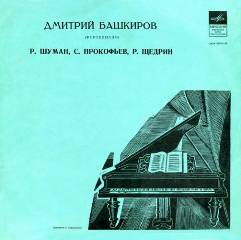Dmitri Bashkirov plays Schumann, Prokofiev, Shchedrin
Dmitri Bashkirov plays Schumann, Prokofiev, Shchedrin

Robert Schumann – Fantasie C Major Op.17 1. Durchaus phantastisch und leidenschaftlich vorzutragen - Im Legendenton - Erstes Tempo - Adagio - Im Tempo 2. Mässig. Durchaus energisch. - Etwas bewegter. - Viel bewegter 3. Langsam getragen. Durchweg leise zu halten. - Etwas bewegter. - Nach und nach bewegter und schneller. – Adagio Sergey Prokofiev - Romeo & Juliet Op.75 4. Romeo & Juliet before parting Rodion Shchedrin 5. Prelude No.16, Basso Ostinato Dmitri Bashkirov – piano
Robert Schumann’s piano works include many unrecognised beauties. One of these is his Fantasie in C major, partly derived from moments in Ludwig van Beethoven’s An die ferne Geliebte. It is uncharacteristically unique in that it depicts Schumann at his most well rooted position within his developing style, before he would turn to a much more standard flow within later works. Naturally, like all other composers, he has moments of distinction and moments of indifference for separation from original musical techniques. His Fantasie stands at each end of the scale for being both confidently conventional, and tentatively experimental.
The work begins with a piece that translates to “Absolutely fantastic and passionate presentation” – a note for the recitalist to avidly maintain whilst performing. In three sections the piece (which itself solely resembles fantasy form) hails through rough landscapes of dense notation, rolling descends in the left with distant melodic accompaniment in the right. It moves into the minor later on, which is much more timely and measured in appearance, with nebulous clouds of chords decaying amongst the romantic melodic line. And finally continues out of sadness and into an area which resembles the manic construction of the first section. It won’t be held up as one of the most recognisable pieces ever composed, but for Schumann is it certainly one of his finest moments in composition.
The other two movements however are more conservative in structure, and rather bland in contrast to the initiator. Part of this arrives at the fact that they are actually compositions which were added on to the original proposition. It’s unclear as to why he did this, because they are musically very foreign to the current formula. The “Massig” begins with much promise behind arpeggiated chords reminiscent of what Modest Mussorgsky later went on to demonstrate in “The Great Gate of Kiev”, but quickly changes into a innocent tone that gallops over the rhythmic waltz like feel. Such a piece feels much more suited for his Kinderszenen (scenes from childhood) suite, and only detracts further from the next movement which again means well in its opening facets, but keeps a constant distance from the well endowed first movement through a similar pattern of melodic and chordal ideas.
Keep in mind though, that while the initiator is much more impressive upon the first listen, the other two movements that make up the better half of the work, do after time make a niche within the listener's area for appreciation. It weevils down to one thing in the end: density. His dense initial ideas that introduce the scheme tip toe around what seems to be a reluctance to show a different form, and yet it is arguably one of his finest moments despite this. And then there are the less dense moments (II, III) that take more time to understand completely within the context, but still have a place is his catalogue and would-be listener. Context aside though, those who cite Schumann’s Fantasie in C, really are alluding to the true essence of the work, which is predominantly to be found in the dreamy landscape of the first movement, making it well worth consideration. --- Jake C. Taylor, sputnikmusic.com
download (mp3 @320 kbs):
uploaded yandex 4shared mega mediafire zalivalka cloudmailru oboom uplea








